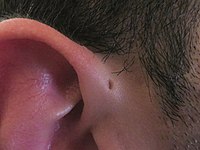Preauricular Sinus And Cyst

A preauricular sinus is a common congenital malformation characterized by a nodule, dent or dimple located anywhere adjacent to the external ear. Frequency of preauricular sinus differs depending the population: 0.1–0.9% in the US, 0.9% in the UK, and 4–10% in Asia and parts of Africa.
Preauricular sinuses are inherited features, and most often appear unilaterally. They are present bilaterally in 25–50% of cases.
Presentation
Complications
Occasionally a preauricular sinus or cyst can become infected. Most preauricular sinuses are asymptomatic, and remain untreated unless they become infected too often. Preauricular sinuses can be excised surgically, but often present a high risk of recurrence.
Causes
Preauricular sinuses and cysts result from developmental defects of the first and second pharyngeal arches. This and other ear malformations are sometimes associated with renal anomalies. In rare circumstances these pits may be seen in genetic conditions such as branchio-oto-renal syndrome; however these conditions are always concurrent with other health concerns.
Treatment
Courses of treatment typically include the following:
- Draining the pus occasionally as it can build up a strong odor
- Antibiotics when infection occurs.
- Surgical excision is indicated with recurrent fistular infections, preferably after significant healing of the infection. In case of a persistent infection, infection drainage is performed during the excision operation. The operation is generally performed by an appropriately trained specialist surgeon e.g. an otolaryngologist or a specialist General Surgeon.
- The fistula can be excised as a cosmetic operation even though no infection appeared. The procedure is considered an elective operation in the absence of any associated complications.
See also
- Branchial cleft cyst
- Thyroglossal cyst
- Lachiewicz Sibley syndrome
- List of cutaneous conditions